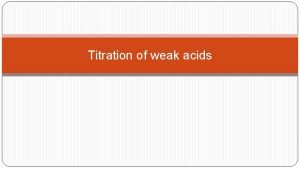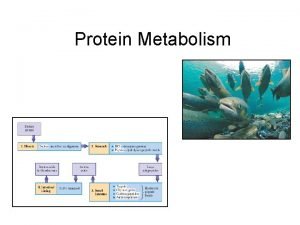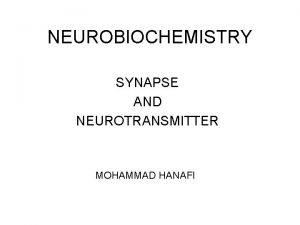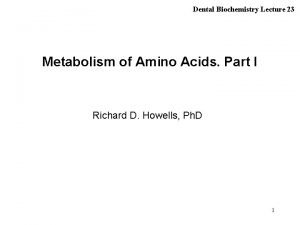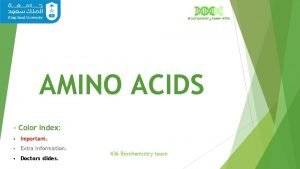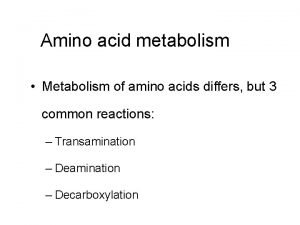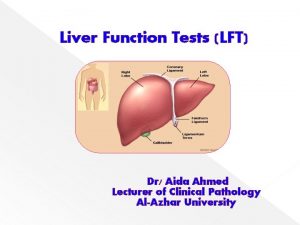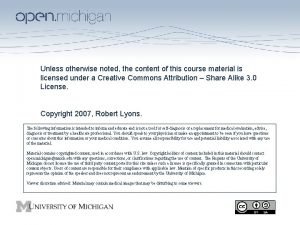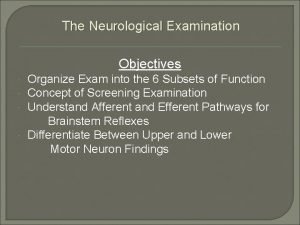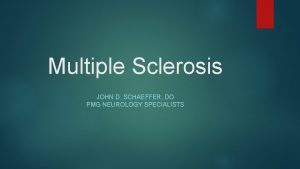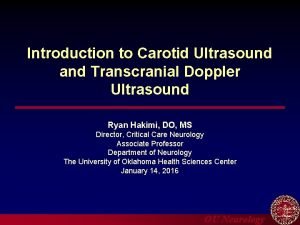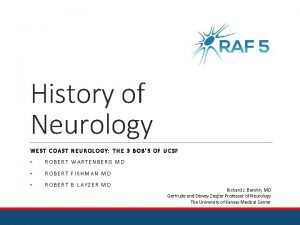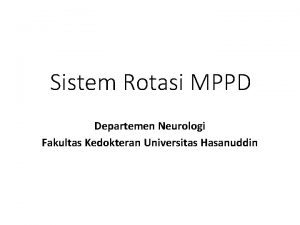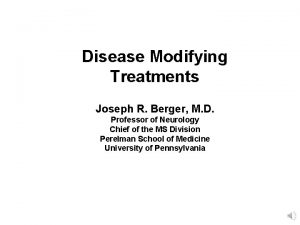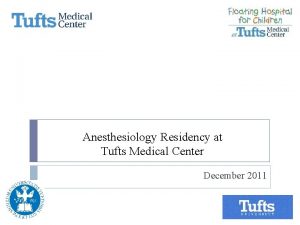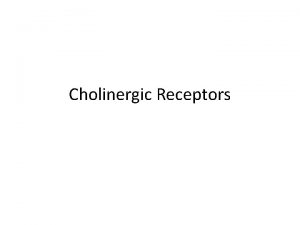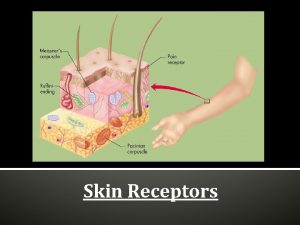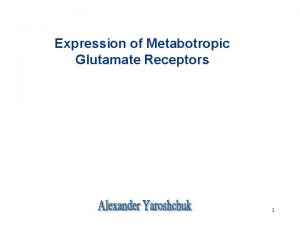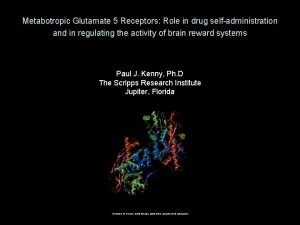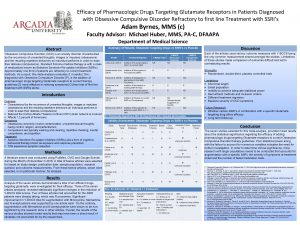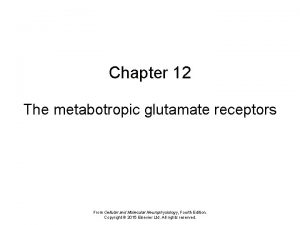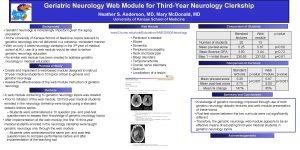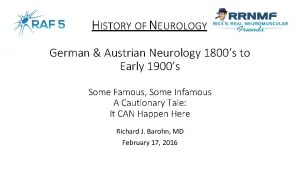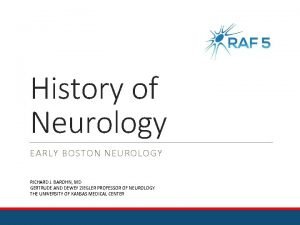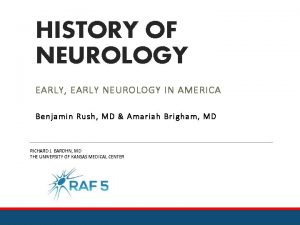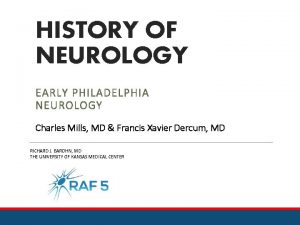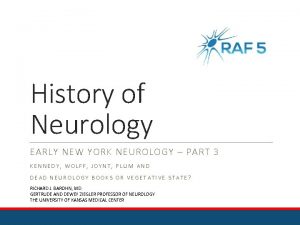Why Glutamate Receptors are Important in Neurology Glutamate




































- Slides: 36

Why Glutamate Receptors are Important in Neurology: Glutamate is present in millimolar quantities in most cells, including neurons and glia Glutamate is the main excitatory neurotransmitter in the mammalian CNS Glutamate is released in large quantities during • Stroke • Trauma • Epilepsy • Possibly in chronic neurological disorders

Why Glutamate Receptors are Important in Neurology: Excess glutamate is released at the synapse through • Synaptic activity • Reverse operation of glutamate transporters • Reduced re-uptake (due to reduced ATP levels) Glutamate levels may rise at the synapse to hundreds of micromolar, which is enough to cause excitotoxicity

What happens to neurons with excess glutamate? Normal Neuron

What happens to neurons with excess glutamate? • Cell Swelling • Dendritic Beading • Axons: no change (? ) Glutamate

Excess glutamate kills neurons through Ca 2+ overload

Calcium Homeostasis Ca ions are ubiquitous intracellular 2 nd messengers responsible for a multitude of cellular functions including • Activation of numerous enzymes responsible for • Gene expression • Protein structure • Metabolic functions (libids, carbohydrates) • The control of differentiation, polarity, synaptogenesis • Synaptic efficacy – neuronal function & activity

Calcium Homeostasis For these reasons cells maintain a very tight control of Ca ions • [Ca 2+]I : [Ca 2+ ] 20, 000 e is 1 : • Ca 2+ ions are sequestered into intracellular organelles • Ca 2+ ions are actively pumped in and out of cellular compartments • Cells contain diverse Ca 2+ buffering molecules to restrict the diffusion of Ca 2+ ions.

Calcium Neurotoxicity “Ca 2+ Excess” is felt to be deleterious to neurons How much is too much remains controversial It is likely that Ca 2+ ions activate distinct 2 nd messenger signaling pathways in neurons that cause them to die. Excitotoxicity causes “Ca 2+ Excess”.

Hypothetical Scheme Leading to Ca Excess: The Case of Neurons

Scheme Leading to Ca Excess: The case of axons (white matter)

Neurotoxic Phenomena triggered by Calcium Excess • The formation of free radical species • Nitric Oxide formation • Calcium Activated Proteases • Endonucleases, Apoptosis, Necrosis • Mitochondrial Damage • Acidosis

Free radicals • Free radicals are reactive oxygen species having a single unpaired electron: • e. g. : Superoxide (O 2 -), hydroxyl (OH-) • Free radicals produce damage by reacting (oxidizing) with critical cellular elements, usually structural proteins, membrane lipids, DNA. • Free radicals are produced mostly in mitochondria.

Mitochondrial e- transport

Superoxide production: Although molecular oxygen is reduced to water in the terminal complex IV by a sequential four-electron transfer, a minor proportion can be reduced by a 1 e addition that occurs predominantly in complex III but also in complex I. A chance exists that this second electron can be transferred to molecular oxygen, generating the superoxide anion O 2·. Thus- normal mitochondria produce a small amount of superoxide. This superoxide is normally scavenged by superoxide dismutase (SOD)

Excitotoxicity and ROS: Calcium loading of isolated mitochondria increases the production of O 2· Excototoxicity causes mitochondrial Ca loading.

Mitochondrial membrane potential upon NMDA exposure

Nitric Oxide Production NO is a gas with a half-life of 6 s. It is produced in: - Vascular endothelium (vasorelaxant) - Glial cells - Neurons It is considered by many to be a neurotransmitter associated with processes related to synaptic plasticity, learning and memory.

NO toxicity: NO is a relatively innocuous gas. However, when combined with superoxide: NO + O 2 - = ONOO- is a highly reactive free radical species that produces damage in neurons.

Nitric Oxide & free radical Production

Calcium activated proteases MAP 2 immunofluorescence Controls NMDA Recovery

Calcium activated proteases (Caplains) Role unclear – felt by most to mediate neuronal damage in stroke. However, some research suggests the reverse- that they may be necessary for neuronal recovery from stroke.

Calcium-activated proteases Calpain Inhibitor No Calpain Inhibitor Calcium-dependent proteolysis contributes to recovery of dendritic structure after NMDA exposure. Calpain activation is not necessarily detrimental and may play a role in dendritic remodeling after neuronal injury.

Endonucleases, apoptosis, necrosis Necrosis: Acute cell death characterized by cell & organelle swelling. Is generally rapid, and occurs due to massive insults. Apoptosis: Slower cell death, characterized by cell shrinkage, nuclear fragmentation, and may be mediated by a “death sequence” dictated by a genetic program.

Endonucleases, apoptosis, necrosis Endonucleases are thought to be calcium-activated enzymes that cleave DNA May be responsible in triggering apoptosis.

How to treat stroke? Concept of therapeutic window: Increases with increased flow. Exact time unknown for humans.

How to treat stroke? 1. Repair the plumbing 2. Make the tissue more resilient to poor plumbing.

How to treat stroke?

The plumbing: Best treatment of plumbing failure is prevention. Risk factors for atherosclerosis - Diabetes - High blood pressure - Hypercholesterolemia - Smoking

The plumbing: Benefit of carotid endarterectomy in patients with symptomatic moderate or severe stenosis. North American Symptomatic Carotid Endarterectomy Trial Collaborators. N Engl J Med 1998 Nov 12; 339(20): 1415 -25

Plumbing After Stroke Onset: Tissue plasminogen activator for acute ischemic stroke. The National Institute of Neurological Disorders and Stroke rt. PA Stroke Study Group. N Engl J Med 1995 Dec 14; 333(24): 1581 -7 “treatment with intravenous t-PA within three hours of the onset of ischemic stroke improved clinical outcome at three months. ”

Plumbing After Stroke Onset: Intra-arterial pro-urokinase for acute ischemic stroke: The PROACT II Study: A randomized controlled trial. JAMA (282) 21, December 1, 1999

Last resort plumbing: :

Last resort plumbing: :

Last resort plumbing: :

Last resort plumbing: :

Last resort plumbing: :
 Antigentest åre
Antigentest åre Hey hey bye bye
Hey hey bye bye Titration curve of glycine
Titration curve of glycine Biliverdin color
Biliverdin color Chemical synapse
Chemical synapse Glutamate oxidative deamination
Glutamate oxidative deamination Glutamate isoelectric point
Glutamate isoelectric point Transamination vs deamination
Transamination vs deamination Transaminase
Transaminase Glutamate
Glutamate Don't ask why why why
Don't ask why why why From most important to least important in writing
From most important to least important in writing Inverted pyramid in news writing
Inverted pyramid in news writing Least important to most important
Least important to most important The walton centre for neurology and neurosurgery
The walton centre for neurology and neurosurgery Neuro exam strength
Neuro exam strength Wake forest neurology residency
Wake forest neurology residency Pmg neurology
Pmg neurology Mary bridge neurology clinic
Mary bridge neurology clinic Duplex vs doppler
Duplex vs doppler West coast neurology
West coast neurology Nbme surgery shelf percentiles
Nbme surgery shelf percentiles Nlff neurology
Nlff neurology Nlff neuro
Nlff neuro Nex exam neurology
Nex exam neurology Department of neurology
Department of neurology Neurology consultants belfast
Neurology consultants belfast Nin bajaj
Nin bajaj Joseph berger md neurology
Joseph berger md neurology Nlff neurology
Nlff neurology Nheent
Nheent Umass neurology residency
Umass neurology residency Midwest neurology
Midwest neurology Neurology
Neurology Miqtu
Miqtu Neurology near loomis
Neurology near loomis Lahey clinic anesthesiology residency
Lahey clinic anesthesiology residency


